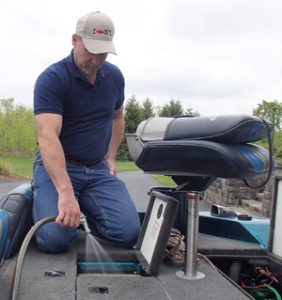Disinfection Techniques for Fishing and Boating Equipment
If your boating and fishing equipment cannot be dried before its use in another body of water, it must be disinfected. Disinfection recommendations vary depending on the type of equipment and disease of concern.
If your boating and fishing equipment cannot be dried before its use in another body of water, it must be disinfected. Disinfection recommendations vary depending on the type of equipment and disease of concern.
_____
Be particularly aware of bilge areas, livewells and baitwells in boats. These areas are difficult to dry and can harbor invasive species. A summary of recommended cleaning materials and techniques are provided below. For an in depth description of how to clean, dry and disinfect various boats and boating equipment download A New York Boaters Guide to Cleaning, Drying and Disinfecting Boating Equipment (PDF) (341 KB).
Effective disinfection techniques include:
Hot Water: Hot water is an effective disinfection agent for all aquatic invasive species and fish diseases. While many of the invasive clam and mussel species can detect other disinfection agents and avoid them by tightly closing their shells, they cannot protect themselves from the effects of high temperature. Soak all equipment in water at least 140°F for 30 seconds. Most tap water is 120º – 130º F, so this will require some additional heating. An inexpensive candy thermometer can be used to determine when you have reached the correct temperature. Note that hot water can delaminate Gore-Tex® fabric and damage other sensitive clothing items. Household steamers may also be used for disinfection by exposing equipment to steam for 30 seconds. Some commercial hot-water car washes can be effective for disinfecting boats and vehicles, but many do not heat water hot enough for proper disinfection.

Bleach: Bleach is also a very effective disinfectant agent, but it is a caustic substance that can be corrosive to aluminum and other sensitive fishing and boating equipment. Soak or spray equipment for at least one minute with a 2% bleach solution (3 ounces of household bleach mixed with 1 gallon of water). If whirling disease is suspected, a 10% solution should be used (13 ounces of household bleach mixed with 1 gallon of water).
Hot water is an effective disinfection agent for all aquatic invasive species and fish diseases.
Potassium Chloride: Commonly used as a substitute for calcium chloride in table salt and home water softeners, potassium chloride (KCL) is a very effective cleanser for boats and equipment used in waters containing zebra or quagga mussels. It also does not have the corrosive side effects of some other cleaning agents. A 200 ppm solution is recommended (one teaspoon of dry KCL salt crystals in 2 gallons of water). KCL salt substitutes can be found in most supermarkets and KCL salt crystals can be special ordered at home improvement or hardware store selling water conditioning products. Given the non-corrosive attributes of KCL, it is particularly useful in cleaning engine cooling systems and other corrosion prone areas.
Flushing: If it is impossible for you to disinfect your boat prior to use, thoroughly flush the bilge and all water holding compartments with water prior to launching. Be sure that this water does not drain into the water body you will be launching your boat into. While a pressurized source of water is preferred, buckets of water may be used if this is not available.

Special Note to Wading Anglers: Felt-soled waders and wading shoes, which have been identified as an important means by which whirling disease spores and didymo can be transported, are difficult to disinfect. Rubber or studded soles are now readily available that provide similar traction, and are much less likely to transport these invasives.


